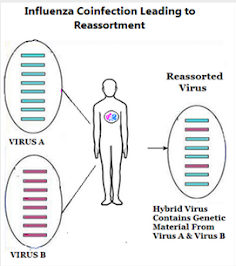- The first (1957) was H2N2, which According to the CDC `. . . was comprised of three different genes from an H2N2 virus that originated from an avian influenza A virus, including the H2 hemagglutinin and the N2 neuraminidase genes.'
- In 1968 a novel H3N2 virus emerged (a reassortment of 2 genes from a low path avian influenza H3 virus, and 6 genes from H2N2) which supplanted H2N2 - killed more than a million people during its first year - and continues to spark yearly epidemics more than 50 years later.
We've seen other examples, which have fallen short of sparking a pandemic. In April of 2020, during the opening of the COVID pandemic, we saw an MMWR Report on a Seasonal H3N2 & H1N1pdm09 Reassortant Infection - Idaho, 2019), involving a 13 year-old boy.
As part of Swedish national influenza surveillance, a seasonal reassortant influenza A(H1N2) virus with a novel genetic constellation was identified. This is the second detected seasonal A(H1N2) reassortant in a human in Europe within 1 year. Here, we describe the detection of the virus, its genetic characteristics and follow-up investigations.
We've also seen worrying co-infections (see Chinese CDC: A Retrospective Investigation of a Case of Dual Infection by Avian A (H10N5) and Seasonal Influenza A (H3N2) Viruses), which - as far as we know - did not lead to a reassortant virus.
While we worry about a potential H5N1/Seasonal flu reassortment - and urge those who work with poultry (and now dairy cattle) to get the flu shot - no one really knows how likely a successful HPAI/Seasonal flu hybrid is to emerge.
All of which brings us to a preprint from Chinese researchers using a deep learning framework tool (HAIRANGE), which suggests that recent iterations of HPAI H5N1 virus and seasonal H3N2 are increasingly well suited for reassortment.
This is, as one might guess, a highly technical report, and one that falls well above my pay grade.
Those with more patience, and a far better understanding of machine learning, genetics, and statistics than I, may want to read the report in full. For those less adventurous, the bottom line can be summed up as:
Based on their tools and analysis, they believe the risk of seeing an H5N1/H3N2 reassortment is relatively high.
Follow the link to read the full report.
Jing Li, Jun-Qing Wei, Ya-Dan Li, Sen Zhang, Shu-Yang Jiang, Yue-Hong Chen, and 6 more
This is a preprint; it has not been peer reviewed by a journal.
https://doi.org/10.21203/rs.3.rs-4989707/v1
This work is licensed under a CC BY 4.0 License
Abstract
Current highly pathogenic H5N1 avian influenza (HPAI H5N1) viruses in bovine and other mammals have been posing unprecedented risks to public health. It’s vital and urgent to assess the pandemic potential of the HPAI H5N1 virus, and the risk degree posed by the virus infection or the genome reassortment with human influenza A viruses (IAVs).An attentional deep learning framework here was constructed of Human Adaptive Influenza virus Reassortment using Attentional Networks based on Genome Embedding (HAIRANGE), to predict high-risk reassortment between avian and human IAVs. HAIRANGE embedded genomic contextual codons covering both RNA and protein information, biologically interpretable on viral adaptive codon contexts of IAVs, predicted accurately adaptive IAV genes and adaptive reassortment between avian and human IAVs on independent validation data sets of RNA polymerase-related genes.A high adaptive reassortment risk was predicted by HAIRANGE of the current bovine HPAI H5N1 viruses with human H3N2 IAVs, as has been in vitro validated with polymerase reporter assay.In summary, the present study provides an intelligent tool to predict high-risk IAV reassortment based on genome embedding. Current bovine HPAI H5N1 is posing high pandemic potential via possible genomic reassortment with human IAVs.
(SNIP)
ConclusionIn summary, there is a human adaption-specific genomic codon context in RNA polymerase-related genes of IAVs, with which, deep learning approaches are capable of predicting the human adaptive reassortment between avian and human IAVs. The reassortment predictor predicted a high risk of adaptive reassortment of the current bovine HPAI H5N1 virus with human H3N2 IAVs, indicating a high public health risk of bovine HPAI H5N1 virus.
